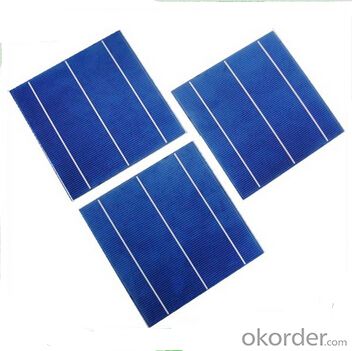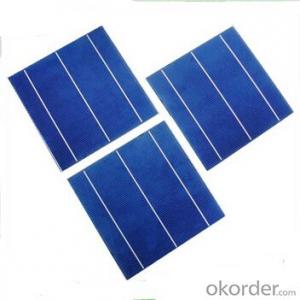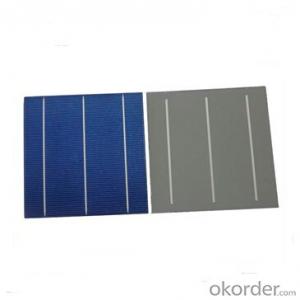Polycrystalline Solar Cells Series- 156mm×156mm±0.5mm
- Loading Port:
- Shanghai
- Payment Terms:
- TT OR LC
- Min Order Qty:
- 3000 pc
- Supply Capability:
- 1000000 pc/month
OKorder Service Pledge
OKorder Financial Service
You Might Also Like
Solar Cells:
Solar cells is made by solar wafer, it has three categories of solar cell right now, monocrystalline polycrystalline and thin film,These cells are entirely based around the concept PN junction, which is the critical part of solar module, it is the part that can convert the light energy into electricity, the thickness is from 180um to 200um, with even busbars to conduct electricity, textured cell can decrease diffuse reflection; they are often electrically connected and encapsulated as a module. Photovoltaic modules often have a sheet of glass on the front (sun up) side, allowing light to pass while protecting semiconductor wafers from abrasion and impact due to wind-driven debris, rain, hail, etc. Solar cells are also usually connected in series in modules, creating an additive voltage. Connecting cells in parallel will yield a higher current;With high quality and stable quality. Our Cells can greatly improve the performance of Solar Modules.
Features:
1. High conversion efficiencies resulting in superior power output performance.
2. Outstanding power output even in low light or high temperature conditions
3. Optimized design for ease of soldering and lamination
4. Long-term stability, reliability and performance
5. Low breakage rate
6. Color uniformity
Solar Cells Advantage:
1. Tire-1 Solar Cells’ Manufacturer Quality Guarantee. With a complete and sophisticated quality government system, our Quality Management have arrived world’s leading place. Customer can receive Tire-1 Cells Maker’s Quality Standard Products.
2. Trusted Warranty. We can supply trusted after-sales service to our customer. If our cells are found not in conformity to the specification of manufacturer, or should the inspected quantity found in shortage, or should the packing found damaged, the buyer has the right to claim to the seller. The claim, if any, should be presented to seller within 30 days after cargo's arrival date to the port, together with related inspection report and photos issued and provided by a reputable independent surveyor such as SGS.
3. World’s Leading Manufacturer Equipment. We imported the newest and leading production equipment from abroad. Advanced equipment can guarantee the stable quality of cells. Auto production line can also save labor cost which will further cut our production cost.
4. Bulk supply: With the production capacity of 500MW, we can produce large quantity every month. This can satisfy most customer requirement.
Specifications:
MECHANICAL DATA AND DESIGN | |
Format | 156mm×156mm±0.5mm |
Thickness | 210μm±30μm |
Front(-) | 1.4mm bus bars(silver), blue anti-reeecting coating(silicon nitride) |
Back(+) | 2mm wide soldering pads(silver) back surface eld(aluminum) |
Efficiency(%) | Pmpp(W) | Umpp(V) | Impp(A) | Uoc(V) | Isc(A) | FF(%) |
19.20-20.00 | 4.67 | 0.547 | 8.542 | 0.64 | 9.15 | 79.79 |
19.00-19.20 | 4.63 | 0.543 | 8.515 | 0.639 | 9.11 | 79.43 |
18.80-19.00 | 4.58 | 0.542 | 8.441 | 0.638 | 9.1 | 78.8 |
18.60-18.80 | 4.53 | 0.54 | 8.382 | 0.637 | 9.084 | 78.23 |
18.40-18.60 | 4.48 | 0.536 | 8.354 | 0.636 | 9.062 | 77.7 |
18.20-18.40 | 4.43 | 0.533 | 8.31 | 0.635 | 9.033 | 77.22 |
18.00-18.20 | 4.38 | 0.532 | 8.234 | 0.634 | 8.987 | 76.88 |
17.80-18.00 | 4.33 | 0.529 | 8.189 | 0.633 | 8.951 | 76.45 |
17.60-17.80 | 4.29 | 0.527 | 8.128 | 0.632 | 8.922 | 75.96 |
17.40-17.60 | 4.24 | 0.525 | 8.066 | 0.629 | 8.902 | 75.63 |

FAQ
We have organized several common questions for our clients,may help you sincerely:
①What price for each watt?
It depends on the efficiency of the solar cell, quantity, delivery date and payment terms.
②How long can we receive the product after purchase?
In the purchase of product within three working days, We will arrange the factory delivery as soon as possible. The pecific time of receiving is related to the state and position of customers.Commonly 7 to 10 working days can be served.
③Can you provide the peripheral products of the solar panels, such as the battery, controller, and inverter? If so, can you tell me how do they match each other?
Yes, we can, we have two companies for solar region, one is CNBM International, the other is CNBM engineering Co.
We can provide you not only the solar module but also the off grid solar system, we can also provide you service with on grid plant.
④What is your warranty of solar cell?
Our product can promise lower than 0.3% open box crack, we support claim after opening the box if it has crackm color difference or sth, the buyer should give pictures immediately, we can not accept the claim after the solar cell has assembled to solar panel.
• Timeliness of delivery
• ⑤How do you pack your products?
We have rich experience on how to pack the solar cell to make sure the safety on shipment, we could use wooden box or pallet as buyer's preference.
- Q:Can solar cells be used in cloudy or rainy conditions?
- Yes, solar cells can still be used in cloudy or rainy conditions, although their efficiency may be reduced. While direct sunlight is ideal for optimal energy production, solar cells can still generate electricity from diffused or indirect sunlight that penetrates through clouds. However, their output will be lower compared to clear and sunny conditions.
- Q:What is the maximum efficiency that a solar cell can achieve?
- The maximum efficiency that a solar cell can achieve is known as the Shockley-Queisser limit, which is approximately 33.7%. However, in practical applications, commercial solar cells typically have efficiencies ranging from 15% to 22%.
- Q:How do solar cells perform in polluted environments?
- Solar cells can still function effectively in polluted environments, although their performance may be slightly reduced. The presence of air pollution, such as smog or particulate matter, can block or scatter sunlight, resulting in a decrease in the amount of energy captured by the solar cells. Additionally, the accumulation of dust and dirt on the surface of the cells can further diminish their efficiency. Therefore, regular cleaning and maintenance are important to optimize the performance of solar cells in polluted environments.
- Q:Can solar cells be used on spacecraft?
- Yes, solar cells can be used on spacecraft. In fact, solar cells are commonly utilized on spacecraft to generate electricity by converting sunlight into usable energy. This provides a reliable and renewable source of power for various systems and instruments onboard the spacecraft.
- Q:Can solar cells be used in telecommunications infrastructure?
- Yes, solar cells can be used in telecommunications infrastructure. They can be used to power various equipment such as base stations, repeaters, and remote monitoring systems. Solar power provides a reliable and sustainable energy source that can be utilized in remote or off-grid locations, reducing dependence on traditional power sources and lowering operational costs. Additionally, solar cells have a longer lifespan and require minimal maintenance, making them an ideal option for powering telecommunications infrastructure.
- Q:Can solar cells be used in industrial applications?
- Yes, solar cells can be used in industrial applications. They are increasingly being utilized in industries such as manufacturing, agriculture, and transportation to generate clean and sustainable energy. Solar cells are capable of powering large-scale operations, reducing reliance on traditional energy sources, and helping businesses reduce their carbon footprint.
- Q:Can solar cells be used in indoor lighting applications?
- Yes, solar cells can be used in indoor lighting applications. However, since solar cells require sunlight to generate electricity, they may not be as efficient in indoor settings where natural light is limited. Additionally, the amount of energy generated may not be sufficient for high-powered indoor lighting, making solar cells more suitable for low-power applications or as supplemental lighting sources.
- Q:What is the impact of solar cells on reducing noise pollution from power generation?
- Solar cells have a positive impact on reducing noise pollution from power generation as they operate silently, without the need for noisy machinery or moving parts.
- Q:Can solar cells be used in theme parks?
- Yes, solar cells can be used in theme parks. Solar cells can be installed in various areas of theme parks to generate renewable energy that can power attractions, lighting, and other facilities. By utilizing solar energy, theme parks can reduce their carbon footprint and promote sustainable practices.
- Q:Can solar cells be used for powering telecommunications towers?
- Yes, solar cells can be used for powering telecommunications towers. Solar panels can generate electricity by converting sunlight into usable energy, which can then be used to power various devices and infrastructure, including telecommunications towers. This renewable energy source provides a sustainable and environmentally friendly solution for powering such towers, especially in remote or off-grid areas.
1. Manufacturer Overview |
|
|---|---|
| Location | |
| Year Established | |
| Annual Output Value | |
| Main Markets | |
| Company Certifications | |
2. Manufacturer Certificates |
|
|---|---|
| a) Certification Name | |
| Range | |
| Reference | |
| Validity Period | |
3. Manufacturer Capability |
|
|---|---|
| a)Trade Capacity | |
| Nearest Port | |
| Export Percentage | |
| No.of Employees in Trade Department | |
| Language Spoken: | |
| b)Factory Information | |
| Factory Size: | |
| No. of Production Lines | |
| Contract Manufacturing | |
| Product Price Range | |
Send your message to us
Polycrystalline Solar Cells Series- 156mm×156mm±0.5mm
- Loading Port:
- Shanghai
- Payment Terms:
- TT OR LC
- Min Order Qty:
- 3000 pc
- Supply Capability:
- 1000000 pc/month
OKorder Service Pledge
OKorder Financial Service
Similar products
New products
Hot products
Hot Searches
Related keywords



























